Losing a good employee costs far more than replacing their role—it drains time, momentum, and often hard-earned team spirit. And in most cases, the signs were there long before the resignation letter landed. People had stopped trusting that employee satisfaction surveys, or any feedback at all, would lead to change.
I’ve seen surveys handled like a tick-box exercise, and the result is always the same: employees tune out. But I’ve also seen what happens when they’re done right. Employee satisfaction surveys can help you identify hidden problems, rebuild trust, and highlight fixes that protect culture and ROI.
In this guide, you’ll find a practical playbook: what employee satisfaction surveys are, how to create them, the questions and templates worth using, strategies for different company sizes, and how to turn feedback into real action.
What Are Employee Satisfaction Surveys?
At the simplest level, an employee satisfaction survey is a tool to understand how people really feel about working in your company, beyond polite nods in meetings. It asks about culture, leadership, workload, growth, and whether employees believe their role is worth sticking around for.
There’s no one-size-fits-all format. Different surveys serve different purposes:
- Satisfaction surveys (the core): Capture overall happiness with role, culture, and workplace basics.
- eNPS surveys: A quick way to measure loyalty by asking, “Would you recommend this company as a place to work?”
- Exit surveys: Run with departing employees to spot patterns behind turnover.
- Candidate experience surveys: Check how applicants feel about your hiring process and employer brand.
- External “employee” CSAT: For companies like EORs, where workers aren’t internal staff but still need their voice heard.
- Pulse surveys: Short, frequent check-ins to catch shifts in sentiment before they become problems.
Think of these as different listening posts. Together, they give you a fuller picture of satisfaction and loyalty—something you can actually act on instead of guessing.
How to Conduct an Employee Satisfaction Survey
Building a survey doesn’t mean you have to start with a blank sheet. The real challenge is making it simple for employees to answer, while giving you data you can actually use. Here are the tried & tested steps to build perfect employee satisfaction surveys:
1. Define the Outcome
Every time I’ve seen a survey flop, it’s because the goal was fuzzy. Decide what you’re solving for—lower turnover, better manager feedback, or stronger culture. Tie it to 2–3 metrics like eNPS or absenteeism.
Why: Clear goals keep the survey short and give you ROI you can actually show later.
2. Decide Audience & Anonymity
One mistake I made early on was blasting a survey to everyone without thinking about anonymity. It backfired—responses were half-hearted because people weren’t sure it was truly confidential. Now I set rules like: “We only share results if 5+ people respond.”
Why: Trust is the foundation of honest feedback.
3. Draft Lean Questions
I’ve seen leaders cram 40+ questions into a survey. Completion tanks. Stick to 10–15 items: mostly rating scales for benchmarks, with a few open-ends for context. Always include an eNPS and a follow-up “Why?” question.
Why: Shorter surveys show respect for employees’ time and still give you insights you can act on.
4. Build Your Survey
Here’s where I save time. Instead of starting blank, I use ProProfs Survey Maker templates—Employee Satisfaction, eNPS, or Exit. Its AI survey maker covers the essentials, and I just tweak wording or add branching (low scores trigger “What would improve this?”).
For shorter, in-the-moment checks, I have used Qualaroo’s nudges. They let you target the right employees with one or two questions, branch responses, and even run sentiment analysis automatically.
Why: Templates prevent overthinking, and microurveys keep you listening continuously.
5. Set Timing & Duration
Run one big survey each year, plus short check-ins every few months. Keep each survey open for about a week and send two reminders.
Why: This gives people enough time to respond without letting it drag on.
6. Plan Distribution
Don’t assume email alone works. I’ve had better results when managers remind their teams on Slack or in meetings. Always make surveys mobile-friendly—it’s how most people will fill them in.
Why: Meeting employees where they are drives response rates up.
7. Pilot Before Launch
I’ve learned to test with 5–10 people first. They’ll spot confusing wording or clunky logic you missed.
Why: A quick pilot saves you embarrassment later.
Employee Satisfaction Survey Questions & Templates
I’ve seen teams get this part wrong more than anything else. They either ask way too many questions, or they ask fluffy ones that don’t lead to action. The sweet spot is 10–15 sharp questions—enough to give you trends and context without burning employees out.
Here’s a practical question bank you can start with:
1. Overall Satisfaction & Morale
- On a scale of 1–10, how satisfied are you with your current role?
- Do you feel motivated to do your best work every day?
- Do you see yourself working here a year from now?
- Do you feel proud to work at this company?
- Do you believe your contributions are valued?
Why: These questions give you your baseline for satisfaction and intent to stay.
You don’t have to start from scratch—you can use this ready-to-use employee satisfaction survey template:
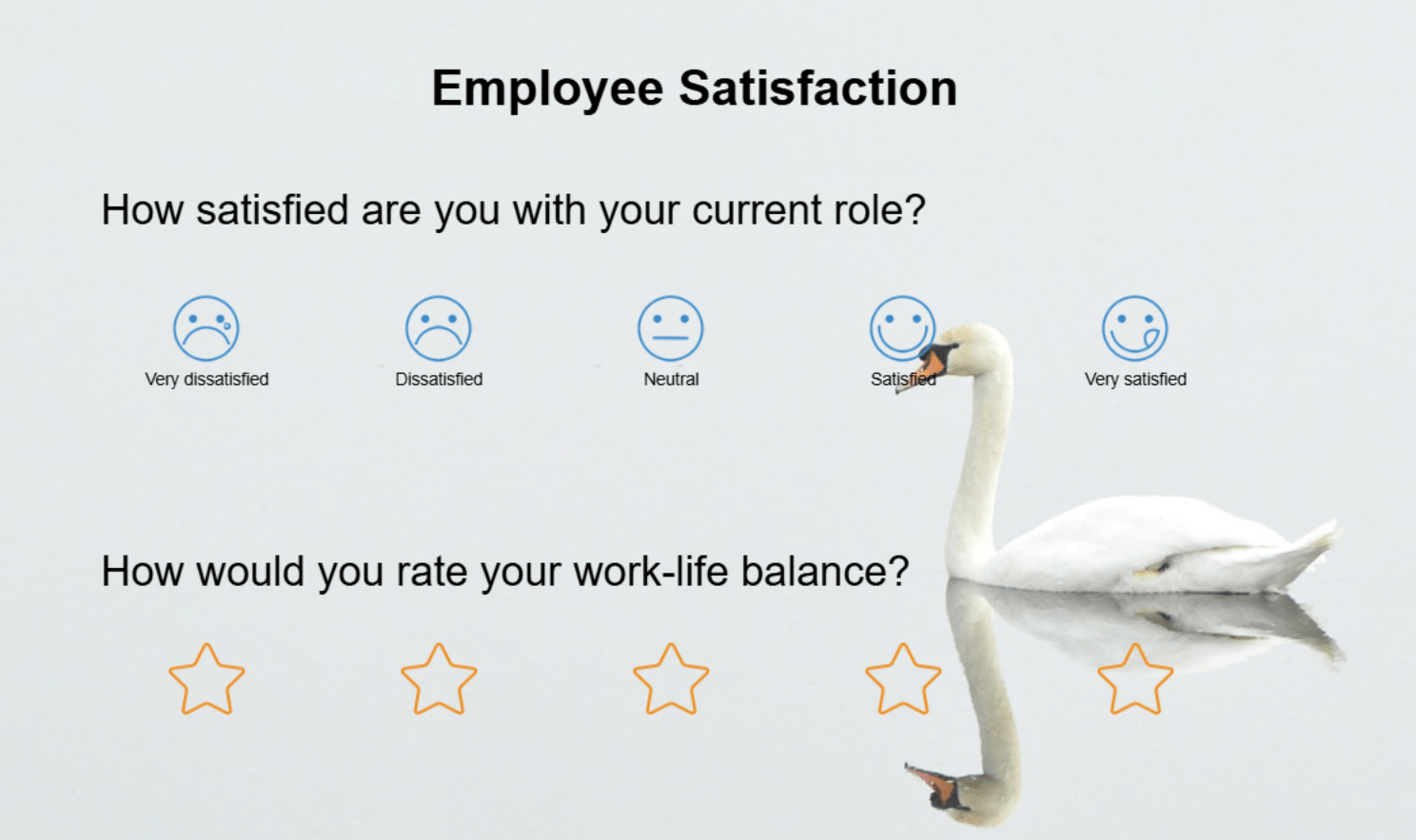
2. Culture & Belonging
- Do you feel connected to the company’s mission and values?
- Does your team respect different opinions and backgrounds?
- Do you feel included in important decisions that affect your work?
- Do you trust your colleagues to collaborate effectively?
- Do you feel comfortable speaking up with new ideas or concerns?
Why: Culture is easy to assume, but hard data shows where it’s actually working.
To save you time, here’s a free culture and belonging survey template:
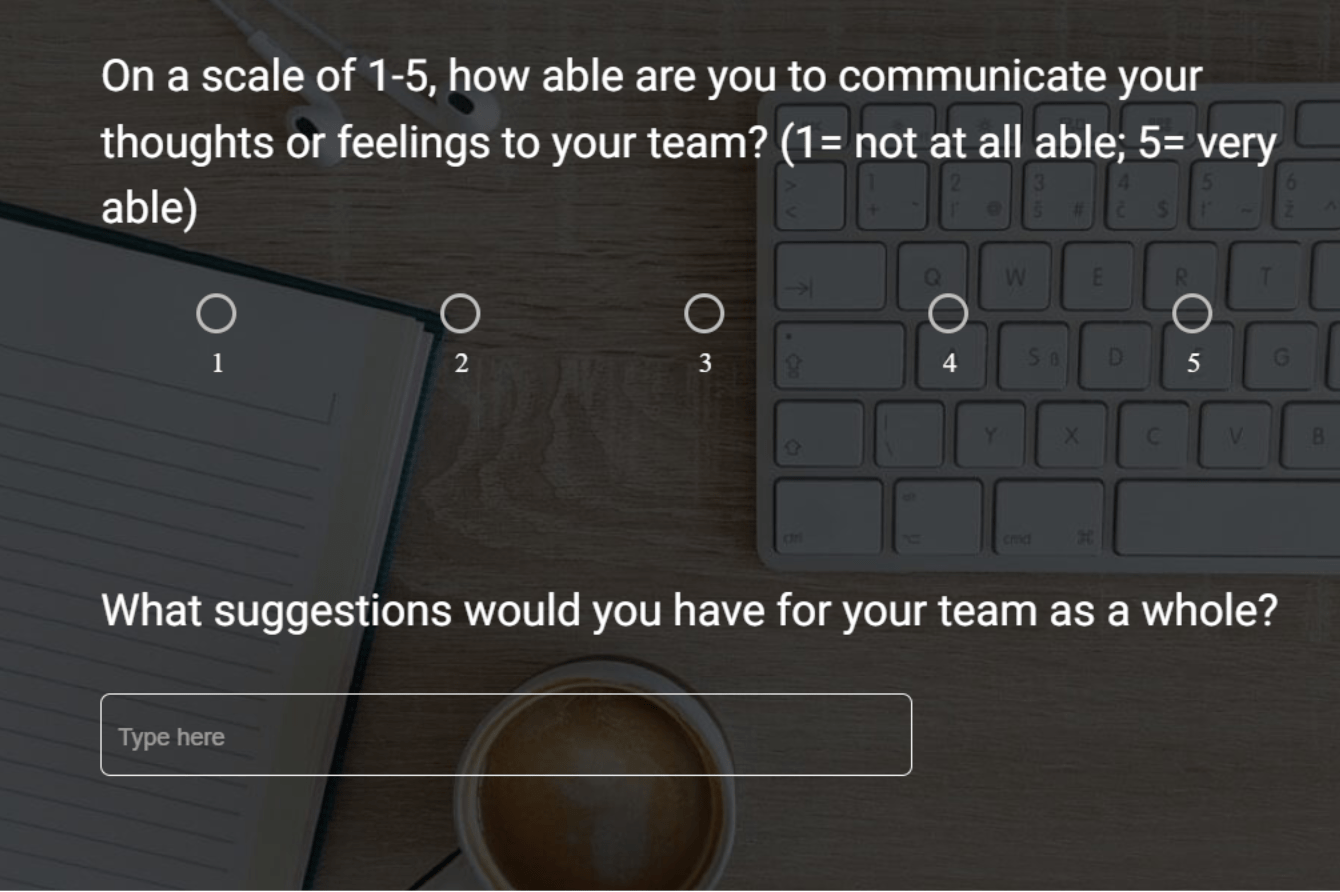
3. Leadership & Management
- Does your manager set clear expectations?
- Do you receive useful feedback that helps you improve?
- Do you feel supported by your manager in your career goals?
- Do you trust leadership to make the right decisions for the company?
- Do you believe leaders communicate transparently and honestly?
Why: Weak leadership almost always shows up here before turnover spikes.
Use this free leadership survey template as a starting point, then tweak the questions to fit your culture:

4. Growth & Development
- Do you have opportunities to learn and grow in your role?
- Are your career goals supported by the company?
- Do you feel there’s a clear path for advancement here?
- Have you been offered training or development opportunities recently?
- Do you believe your skills are being fully utilized?
Why: Growth questions reveal if people are just doing a job—or building a career with you.
Here’s a practical employee satisfaction survey template—adapt it as you see fit.
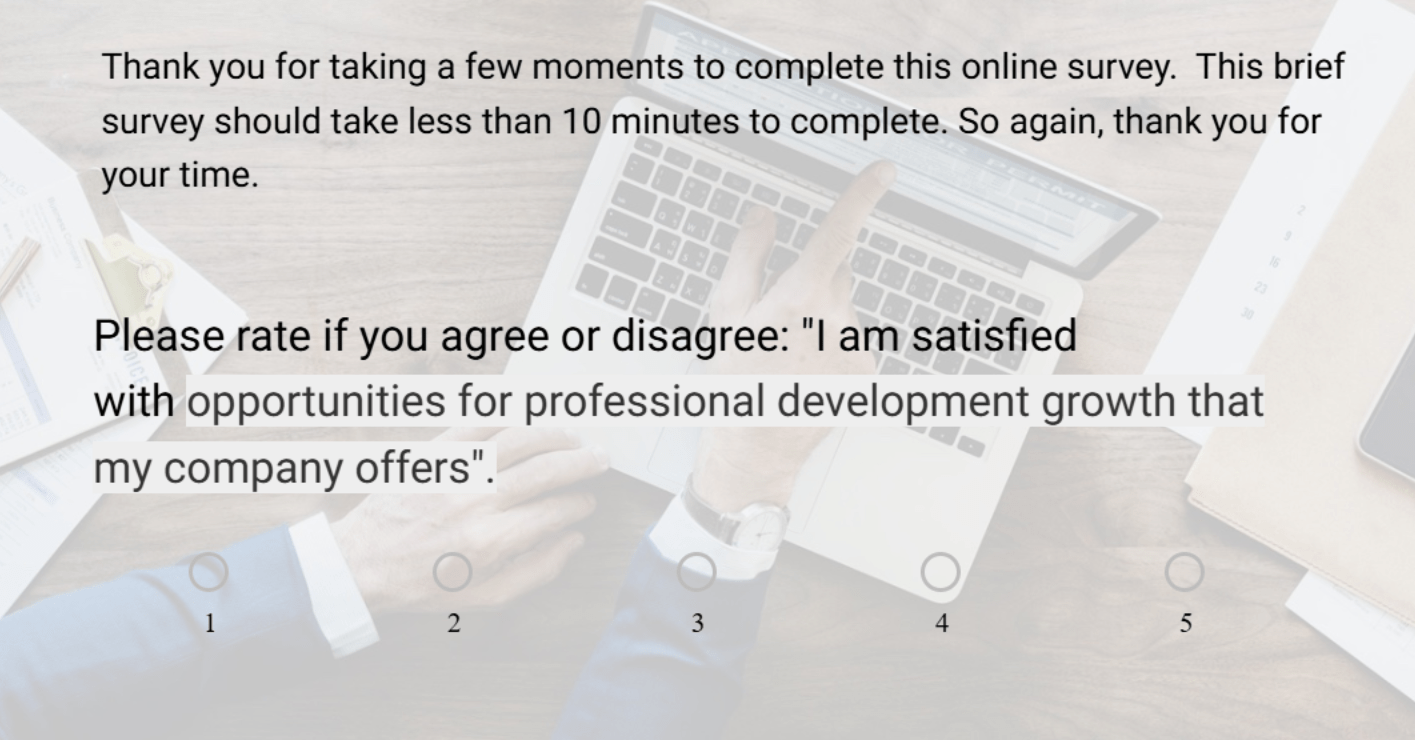
5. Work-Life Balance & Support
- Can you balance work and personal life effectively?
- Do you feel comfortable taking time off when needed?
- Do you have the tools and resources to do your job well?
- Is your workload manageable on most days?
- Do you feel supported by the company in maintaining your wellbeing?
Why: Burnout and poor enablement drive hidden disengagement.
6. eNPS & Branching Follow-Ups
- How likely are you to recommend this company as a place to work? (0–10)
- If 0–6: What would improve your experience here?
- If 7–8: What could turn this into a 9 or 10?
- If 9–10: What do you value most about working here?
- What’s one change you’d suggest to make this a better place to work?
Why: eNPS is your loyalty score; branching turns it into actionable insights.
To make things easier, here’s an eNPS survey template you can plug straight into your process:
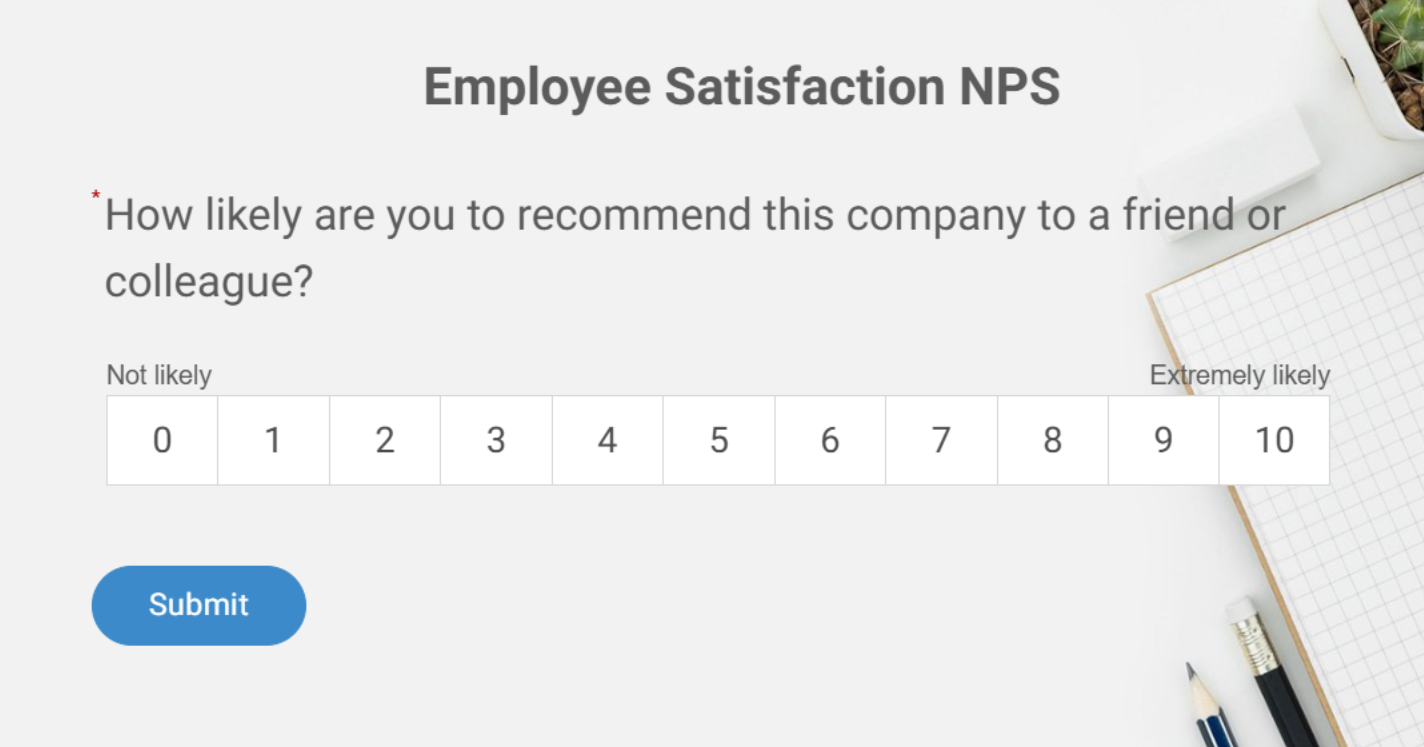
Template Shortcut: Instead of manually writing these from scratch, I’d lean on ProProfs AI Survey Maker. Drop in your goal (e.g., “Employee Satisfaction” or “Exit Survey”), and it generates a draft survey with the right mix of questions. You can then adjust wording, add branching, and keep it consistent with your company’s tone.
For lightweight pulse checks in between big surveys, Qualaroo nudges are perfect—ask one or two quick questions in Slack, Microsoft Teams, or your intranet to keep a steady flow of feedback.
Example: After rolling out a new remote work policy, you could send a quick Qualaroo nudge asking, “How is the new policy working for you so far?”
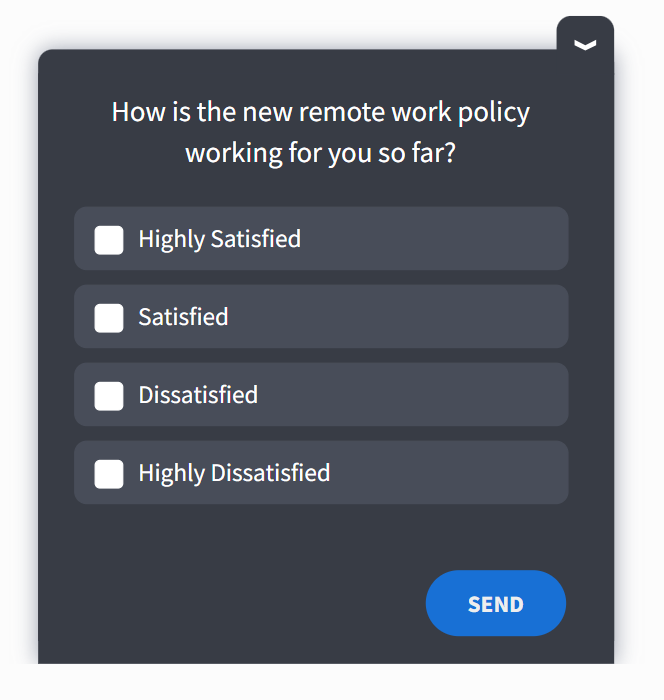
Survey Strategies by Company Size
Not every company should run surveys the same way. A 50-person startup and a 5,000-person enterprise face different challenges, budgets, and legal guardrails. Here’s how to approach it depending on where you are:
| Company Size | How to Run Surveys | Best Practices | ROI Angle | Legal & Ethical Notes |
|---|---|---|---|---|
| Small (≤150 employees) | Annual survey (10–15 Qs) + quarterly pulse | Use ProProfs AI Survey Maker to spin up surveys fast; share results openly; act on 2–3 fixes quickly | Retaining even 1 employee can save months of salary | Keep it voluntary and confidential; avoid identifying individuals |
| Mid-Sized (150–1,000 employees) | Annual survey + quarterly pulse with automation | Automate reminders/reports; segment by team or location; managers host follow-up sessions | Cutting turnover 10–15% = six-figure savings | Anonymity threshold: don’t share team data if |
| Large (1,000+ employees) | Annual benchmark + monthly pulses (e.g., Qualaroo nudges) | Continuous listening program; advanced analytics; publish org-wide actions; train managers on acting fast | Even a 1–2% drop in attrition = millions saved | Comply with GDPR/CCPA; run DPIAs; use secure data transfers and anti-retaliation policies |
FREE. All Features. FOREVER!
Try our Forever FREE account with all premium features!
How to Communicate & Roll Out Your Employee Satisfaction Survey
A well-designed survey won’t matter if no one fills it out. Rollout is half the battle. Here’s a simple framework you can follow:
1. Manager Talking Points: Build Trust
Provide managers with a two- to three-sentence script for team meetings:
“The survey is anonymous. We’ll only see group results, and leadership has committed to acting on the top themes within 30 days.”
- Why: Employees are more likely to trust their manager than a corporate email.
2. Timing: Pick the Right Moment
Avoid launching during busy seasons, holidays, or stressful events like layoffs. Aim for a steady period when employees can give thoughtful responses.
- Why: Timing affects how honest and complete feedback will be.
3. Reminders: Keep It Light
Plan two reminders—one halfway through, one just before closing. Keep them brief and encouraging.
- Why: Timely nudges increase completion rates without annoying employees.
4. Post-Survey Communication: Close the Loop
Share a timeline for next steps: “Results will be summarized in two weeks; actions will be announced within 30 days.” Stick to it.
- Why: Following through builds trust and credibility.
Tool Note: In ProProfs AI Survey Maker, you can automate reminders, set survey close dates, and even generate draft announcement emails. For shorter one-question reminders or follow-ups, Qualaroo can be used as a lightweight pulse tool.
Why Employee Satisfaction Surveys Matter
Employee satisfaction isn’t just about keeping people happy—it directly affects how your business performs. When employees feel valued and supported, they stay longer, collaborate better, and push harder toward company goals. When they don’t, you pay for it through higher turnover, lost productivity, and disengaged teams.
There are a lot of benefits of employee satisfaction surveys. They give you a way to measure what’s working and what’s broken. Without them, you’re relying on guesswork and hallway chatter. With them, you can pinpoint the issues that cause frustration—unclear roles, poor communication, lack of growth opportunities—and act before they turn into resignations.
The payoff is real: research shows that highly engaged business units experience 78% less absenteeism and 14% higher productivity compared to disengaged ones. That’s not a soft “feel-good” benefit—it’s money saved on lost time and gains in output you can measure.
In short, staff satisfaction surveys matter because they connect culture to the bottom line, turning feedback into a tool for retention, performance, and growth.
What Comes After Collecting Employee Feedback?
Surveying employee satisfaction isn’t the finish line—it’s the starting point. The real ROI comes when you turn raw responses into trust, actions, and measurable improvements.
Here’s how to close the loop:
1. Thank Employees Immediately: A quick all-hands note or email shows their input is valued. I’ve seen participation rise when people know their voice mattered last time.
2. Share the Results Openly: Don’t bury the data. Publish top themes—good and bad—at the company or team level. Transparency builds credibility.
3. Prioritize 2–3 Key Fixes: Trying to solve everything at once spreads you thin. Pick the changes that will have the biggest impact on retention or morale.
4. Assign Owners and Deadlines: Whether it’s updating career paths or fixing workload issues, give each action a clear owner and a timeline. Accountability keeps momentum alive.
5. Follow Up With Pulses: Use a quick pulse to check if the changes are working. Short surveys confirm whether actions are landing as intended.
6. Track Progress Over Time: Compare results against your last survey, and monitor key metrics like eNPS, turnover, or absenteeism. Create a simple dashboard to show trends by quarter or year.
The Takeaway: Collecting feedback without acting on it kills trust. Acting visibly, even on small fixes, is what makes surveys worth running in the first place.
Common Roadblocks in Employee Satisfaction Surveys (& How to Overcome Them)
Even with the best survey design, a few blockers almost always show up. Here’s what to expect—and how to beat them:
| Roadblock | What It Looks Like | How to Fix It |
|---|---|---|
| Low Response Rates | Employees skip surveys or abandon them halfway. | Keep surveys under 15 minutes, explain why feedback matters, and set a clear timeline for sharing results. |
| Employee Skepticism | People think surveys are a box-ticking exercise with no follow-through. | Always close the loop: share key findings and 2–3 visible actions within 30 days. |
| Manager Resistance | Some managers dismiss results or see them as extra work. | Train managers to interpret data, run short team debriefs, and link scores to retention/ROI. |
| Privacy Concerns | Employees don’t trust “anonymous” really means anonymous. | Use anonymity thresholds (e.g., no results shown if |
| Overcomplicated Tools | Survey platforms feel heavy, adoption lags. | Start simple with ProProfs AI Survey Maker templates; use Qualaroo for quick pulse questions. |
FREE. All Features. FOREVER!
Try our Forever FREE account with all premium features!
Ready to Move From Feedback to Action?
Employee satisfaction surveys only matter if they lead to action. When you ask the right questions, share results openly, and follow through, you build trust and protect retention. Tools like ProProfs AI Survey Maker for full surveys and Qualaroo for quick pulses make it easy to keep feedback flowing.
The payoff isn’t just higher scores—it’s fewer exits, a stronger culture, and a workforce that knows its voice matters.
Start small, be transparent, and commit to acting on what you hear. That’s how you turn surveys from a checkbox exercise into a growth engine for your company and a meaningful tool for your team.
Frequently Asked Questions
How do I overcome employee skepticism about anonymity?
Many employees worry “anonymous” isn’t really anonymous. The fix is transparency. Set anonymity thresholds (for example, don’t show team data if fewer than five people respond) and clearly explain how responses are stored and reported. Choosing tools that mask identifiers by default also reassures employees that their feedback won’t come back to haunt them.
What if managers resist employee feedback?
It’s common for managers to feel defensive about survey results. The best approach is training them to interpret data constructively and involving them in action planning. Pair the data with facilitated discussions at team level. When managers see that acting on feedback improves performance and retention, resistance usually turns into ownership.
How to measure employee satisfaction?
The simplest way is through well-designed surveys—both annual and short pulse checks. Combine rating-scale questions (like eNPS or satisfaction scores) with open-text responses to understand the “why” behind the numbers. Beyond surveys, you can track indirect signals such as turnover rates, absenteeism, internal promotion rates, and even participation in training or development programs. Together, these data points give you a fuller picture of how satisfied employees are and where to focus improvements.
How do I show ROI from employee satisfaction surveys?
Start with turnover savings: multiply the number of employees retained by the cost of replacing each one (often 0.5–1.5x salary). Then add softer but trackable wins like lower absenteeism, higher eNPS, or productivity gains. Over time, compare current scores with past surveys. Showing trends quarter by quarter helps prove the financial and cultural return on running surveys consistently.
 Tips
Tips
We’d love to hear your tips & suggestions on this article!
FREE. All Features. FOREVER!
Try our Forever FREE account with all premium features!


 We'd love your feedback!
We'd love your feedback! Thanks for your feedback!
Thanks for your feedback!

